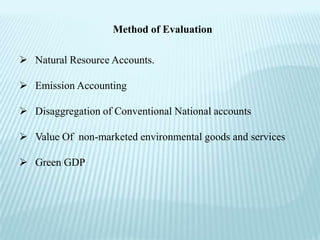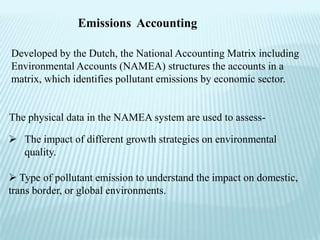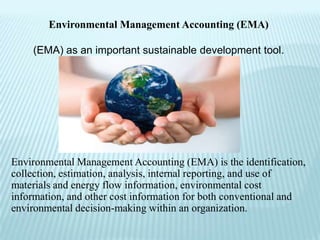Environmental accounting
- 1. Environmental Accounting ABHINAV RAI
- 2. The economy and the environment Environment Extractions Insertions The economy extracts materials and energy from the environment, using them along with capital and labour to produce Economy the means to the satisfaction of human needs and wants, and inserts back into the environment an equal mass of waste . Satisfactions E = S/I with E for efficiency S for satisfaction I for (environmental) input
- 3. Economic concept The concept of Gross Domestic Product is a flow measure that denotes the value of the goods and services produced during a period as a result of the production activity of resident producer units. GDP does not take into account the decrease in the value of fixed assets (e.g computers, buildings, transport equipment, machinery, etc.) used in the production process. The proper measure of economic performance is Net Domestic Product (NDP) which is Gross Domestic Product (GDP) less the depreciation of reproducible capital.
- 4. Environmental valuation Environmental valuation is the process of putting monetary values on environmental goods and services (G&S), many of which have no easily observed market prices. Environmental valuation is a series of techniques that economists use to assess the economic value of market and non-market goods, namely natural resources and resource services.
- 5. Environmental Accounting Environmental accounts provide data which highlight both the contribution of natural resources to economic well-being and the costs imposed by pollution or resource degradation Environmental accounting" - sometimes referred to as "green accounting", "resource accounting" or "integrated economic and environmental accounting" - refers to modification of the System of National Accounts to incorporate the use or depletion of natural resources.
- 6. The System of National Accounts (or SNA) is the set of accounts which national governments compile routinely to track the activity of their economies. SNA data are used to calculate major economic indicators including gross domestic product (GDP), gross national product (GNP), savings rates, and trade balance figures.
- 8. Environmental accounting – functional aim Identify & reduce negative environmental impact of conventional accounting Separately identify environmentally related costs & revenues within conventional accounting Try to reconcile the conflict between conventional & environmental criteria Devise new forms of financial & non-financial accounting systems, information & control systems to support more environmentally benign management decisions Develop new forms of performance appraisal for internal & external purposes Operationalise sustainability
- 9. Method of Evaluation Natural Resource Accounts. Emission Accounting Disaggregation of Conventional National accounts Value Of non-marketed environmental goods and services Green GDP
- 10. Natural Resource Accounts Stocks of natural resources and changes in them caused by either natural processes or human use. They are of two types Physical asset account and Monetary asset account Such accounts typically cover Agricultural land, Fisheries, Forests, Minerals and Petroleum, Water. Evaluation Value of Resources when goods are sold in Market Value of Stock/ goods that are not sold in Market Physical changes in Resources Fluctuation in Market Price
- 11. Emissions Accounting Developed by the Dutch, the National Accounting Matrix including Environmental Accounts (NAMEA) structures the accounts in a matrix, which identifies pollutant emissions by economic sector. The physical data in the NAMEA system are used to assess- The impact of different growth strategies on environmental quality. Type of pollutant emission to understand the impact on domestic, trans border, or global environments.
- 12. Disaggregation of conventional national accounts` Sometimes data in the conventional accounts are taken apart to identify expenditures specifically related to the environment, such as Those incurred to prevent or mitigate harm, To buy and install protection equipment, Pay for charges and subsidies
- 13. Value of non marketed environmental goods and services. Whether to include the imputed value of non marketed environmental goods and services Value of these items is crucial if the accounts are to be used to assess tradeoffs between economic and environmental goals The accounts can end up reflecting the costs of protecting the environment without in anyway reflecting the benefits.
- 14. Green GDP. Developing a gross domestic product that includes the environment Actively involved in building environmental accounts minimize its importance because environmental accounting methods are not standardized A green GDP can draw attention to policy problems, it is not useful for figuring out how to resolve them.
- 15. Environmental Management Accounting (EMA) (EMA) as an important sustainable development tool. Environmental Management Accounting (EMA) is the identification, collection, estimation, analysis, internal reporting, and use of materials and energy flow information, environmental cost information, and other cost information for both conventional and environmental decision-making within an organization.
- 16. Uses And Benefits Of EMA
- 17. Uses & Benefits of EMA > The ability to more accurately track and manage the use and flows of energy and materials, including pollution/waste volumes, types, and fate. > The ability to more accurately identify, estimate, allocate, and manage/reduce costs, particularly environmental types of costs. > Improves Company Image with Stake Holder’s > The lower the financial, political, and other burdens of environmental protection on government. > Implementation of EMA by industry should strengthen the effectiveness of existing government policies/regulations by revealing to companies benefits resulting from those policies/regulations
- 18. EMA CHALLENGES Current Accounting Practices Communication/links between accounting and other departments often not well developed Materials use, flow and cost information often is not tracked adequately Investment decisions are often made on the basis of incomplete information Many types of environment-related cost information are not found in the accountin grecords
- 19. Relationship of EMA to Other Environmental Management Initiatives Pollution Prevention and Cleaner Production Environmental Life Cycle Assessment/Costing/Design Environmentally Preferable Purchasing Extended Producer/Product Responsibility Environmental Performance Evaluation & Benchmarking Environmental Supply Chain Management


















